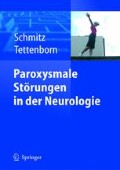Access this chapter
Tax calculation will be finalised at checkout
Purchases are for personal use only
Preview
Unable to display preview. Download preview PDF.
Literatur
Aguglia U, Tinuper P, Gastaut H (1984) Startle-induced epileptic seizures. Epilepsia 25:712–720
Auger R (1994) Diseases associated with excess motor unit activity. Muscle Nerve 17:1250–1263
Baldissera F, Cavallari P, Dworzak F (1994) Motor neuron ‚bistability‘. A pathogenetic mechanism for cramps and myokymia. Brain 117:929–939
Berardelli A, Cruccu G, Kimura J, Ongerboer de Visser B, Valls-Sole J (1999) The orbicularis oculi reflexes. The International Federation of Clinical Neurophysiology. Electroencephalogr Clin Neurophysiol Suppl 52:249–253
Brasic J (2001) Quinine-induced thrombocytopenia in a 64-year old man who consumed tonic water to relieve nocturnal leg cramps. Mayo Clin Proc 76:863–864
Brown P, Rothwell J, Thompson P, Britton T, Day B, Marsden C (1991) The hyperekplexias and their relationship to the normal startle reflex. Brain 114:1903–1928
Brown P, Thompson P (2001) Electrophysiological aids to the diagnosis of psychogenic jerks, spasms, and tremor. Mov Disord 16:595–599
Deecke L, Müller B, Conrad B (1983) Standardisierung des elektromyographischen Tetanietests in der Diagnose der normokalzämischen Tetanie: 10-minütiger Trousseau bei Patienten und gesunden Kontrollen. Arch Psychiatr Nervenkr 233:23–37
Denny-Brown D, Foley J (1948) Myokymia and the benign fasciculation of muscle cramps. Trans Assoc Am Phy 61:88–96
Diener H, Dethlefsen U, Dethlefsen-Gruber S, Ver P (2002) Effectiveness of quinine in treating muscle cramps: a double-blind, placebo-controlled, parallel-group, multicentre trial. Int J Clin Pract 56:243–246
Gutman L (1991) Facial and limb myokymia. Muscle Nerve 14:1043–1049
Howard R, Ford R (1992) From the jumping Frenchmen of Maine to posttraumatic stress disorder: the startle response in neuropsychiatry. Psychol Med 22:695–707
Jusic A, Dogan S, Stojanovic V (1972) Hereditary persistent distal cramps. J Neurol Neurosurg Psychiatry 35:379–384
Layzer R (1994) The origin of muscle fasciculations and cramps. Muscle Nerve 17:1243–1249
Manford M, Fish D, Shorvon S (1996) Startle provoked epileptic seizures: features in 19 patients. J Neurol Neurosurg Psychiatry 61:151–156
Matsumoto J, Fuhr P, Nigro M et al. (1992) Physiological abnormalities in hereditary hyperekplexia. Ann Neurol 32:41–50
Matsumoto J, Hallett M (1996) Startle syndromes. In: Marsden CD, Fahn S (eds) Movement disorders 3. Butterworth Heinemann, London, pp 418–433
McGee S (1990) Muscle cramps. Arch Intern Med 150:511–518
Meinck H-M (2001) Syndrome mit gesteigerter neuromuskulärer Erregbarkeit: Stiff-man-Syndrom und Neuromyotonie. In: Berlit P (Hrsg) Immunglobuline in der klinischen Neurologie. Steinkopff, Darmstadt, S 151–165
Meinck H (2001) Stiff man syndrome. CNS Drugs 15:515–526
Meinck H-M, Thompson P (2002) Stiff man syndrome and related conditions. Mov Disord 17:853–866
Mertens H, Zschocke S (1965) Neuromyotonie. Klin Wochenschr 43:917–925
Newsom-Davis J, Mills K (1993) Immunological associations of acquired neuromyotonia (Isaacs’ syndrome). Report of five cases and literature review. Brain 453–469
Parisi L, Pierelli F, Amabile G et al. (2003) Muscular cramps: proposals for a new classification. Acta Neurol Scand 107:176–186
Roffe C, Sills S, Crome P, Jones P (2002) Randomised, crossover, placebo controlled trial of magnesium citrate in the treatment of chronic persistent leg cramps. Med Sci Monit 8:CR 326–330
Rowland L (1985) Cramps, spasms and muscle stiffness. Rev Neurol 141:261–273
Shahani B, Young R (1980) The flexor reflex in spasticity. In: Feldman R, Young R, Koella W (eds) Spasticity: disordered motor control. Symposia Specialists, Chicago, pp 287–300
Shiang R, Ryan S, Zhu Yea (1993) Mutations in the alpha 1 subunit of the inhibitory glycine receptor cause the dominant neurologic disorder, hyperekplexia. Nat Genet 5:351–358
Thompson P, Colebatch G, Brown P, Rothwell J, Day B, Obeso J, Marsden C (1992) Voluntary stimulus-sensitive jerks and jumps mimicking myoclonus or pathological startle syndromes. Mov Disord 7:257–262
Tijssen M (1997) Hyperekplexia-startle disease. Neurology. Rijksuniversiteit Leiden, pp 1–173
Tijssen M, Shoemaker H, Edelbroek P, Roos R, Cohen A, Dijk Jv (1997) The effects of clonazepam and vigabatrin in hyperekplexia. J Neurol Sci 149:63–67
Tranchant C, Bhatia K, Marsden C (1995) Movement disorders in multiple sclerosis. Mov Disord 10:418–423
Tuite P, Navarette C, Bril V, Lang A (1996) Idiopathic generalized myokymia (Isaacs’ syndrome) with hand posturing resembling dystonia. Mov Disord 11:448
Veltkamp R, Krause M, Schranz S, Meinck H (2003) Progressive nonatrophic arm weakness and tonic spasm: isolated manifestation of multifocal motor neuropathy in the brachial plexus. Muscle Nerve 28
Vincent A (2000) Understanding neuromyotonia. Muscle Nerve 23:655–657
Young G, Jewell D (2002) Interventions for leg cramps in pregnancy. Cochrane Database Syst Rev:CD000121
Author information
Authors and Affiliations
Editor information
Editors and Affiliations
Rights and permissions
Copyright information
© 2005 Springer Medizin Verlag Heidelberg
About this chapter
Cite this chapter
Meinck, HM. (2005). Krämpfe, Spasmen und verwandte Symptome. In: Schmitz, B., Tettenborn, B. (eds) Paroxysmale Störungen in der Neurologie. Springer, Berlin, Heidelberg. https://doi.org/10.1007/3-540-26665-8_10
Download citation
DOI: https://doi.org/10.1007/3-540-26665-8_10
Publisher Name: Springer, Berlin, Heidelberg
Print ISBN: 978-3-540-40789-8
Online ISBN: 978-3-540-26665-5
eBook Packages: Medicine (German Language)

